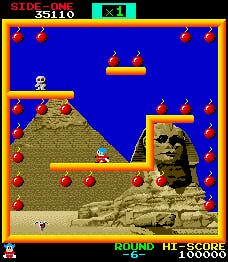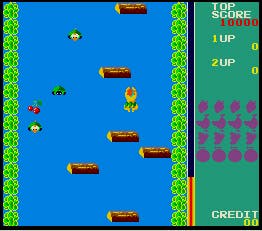Tecmo Classic Arcade
Everyone else is doing it, so why can't Tecmo?
There's only so much nostalgia any balanced human being should be subjected to at any one time. Before long, the numbers involved start to compute in your increasingly frazzled brain and it slowly dawns on you that a quarter of a century has passed since these games blooped and bleeped away in that smoky old arcade you used to frequent.
But when it comes to the Tecmo Classic Arcade collection, the feeling isn't so much one of nostalgia, but of incredulity that anyone in their right minds could abuse the word 'classic' with some of these also-rans. Without any fear of contradiction, this is easily one of the worst retro collections we've ever had the misfortune to cross paths with.
Tackling the releases chronologically, the compilation kicks off with a run-of-the-mill Galaga clone called Pleiads (and no, we've no idea how to pronounce that, either). Carbon-dated to 1981, it's one of those done-to-death shooters where wave upon wave of scary space invaders swoop down at you in relatively predictable patterns, showering you with bullets. It's proper old-school 'one bullet and you're dead', in the days when continues weren't even invented and you were grateful for three lives. Apparently, playability was off the menu, too, as next to the eternal majesty of Namco's bona-fide classic this comes across as a hollow facsimile with little charm of its own.
Drown it
Next on the menu, we're treated to the bizarre Swimmer, from 1982. Described in the sales sheet as "so realistic you'll want to bring a towel and suntan lotion to your favourite location", you have to control a swimmer on a hazardous journey up the course of a river. The closest comparison is probably Frogger (or Horace Goes Skiing!) in terms of concept, with the basic idea to duck and dive under logs, turtles and assorted crab monsters (in a river? Apparently). Seeing as its 1982, it's hardly surprising that the animations are awful, the colour scheme as garish as you can get, and the gameplay as repetitive as you can imagine. Oh, and the warbling little ditty is terrifyingly annoying to boot.
And so we move on to 1983's Senjyo, a sort of sprite-based rip-off of BattleZone, which is to say an early attempt at some sort of first-person 3D shooting experience. In the game, you're behind some sort of turret, with the idea to zap 32 space tanks on each level in a simulated 360 degree environment (which in real terms means the playfield wraps around once you reach the edge). The game's fun for a few minutes' mindless blasting, and then you start to get jarred off with the sluggish fire-rate, which ensures that you'll miss even when you think you're bang on target. Another non-classic also-ran that no-one should be reminded about.
Things improve a notch with the 1984 top-down vertically scrolling shooter Starforce, a fairly fast-paced affair that was part of the genre that provided inspiration for an entire generation of 8-bit home computer shooters of the mid '80s. Following on from the likes of Xevious, it sports all the familiar hallmarks: the occasional power-ups, the ability to shoot bits of the scenery, the rinky-dink theme tune that burbles away merrily in the background for no good reason. Its sole innovation was the need to shoot a floating letter at the end of each level, which if you missed required you to replay a small section before having another go. Starforce isn't bad for a few minutes of mindless blasting, but is yet another Tehkan (what Tecmo used to be known as) release that was happy to be an also-ran at the time rather than an innovator. There are tons of better shooters to seek out from the era than this.
The original Bomberman

Far better is the hugely popular Bomb Jack (also from 1984), which proved to be a massive success on the C64, Spectrum and Amstrad a year later. Probably best described as 'Pac-Man with bombs and cool backdrops', the idea was to clear the screen of bombs while avoiding the various patrolling enemies that lurked and spawned within the confines of the single screen level. A novel (for the time) control system gave you a surprisingly flexible degree of control over 'Jack, allowing you to flap and slow your descent. Collecting fizzing bombs in sequence provided power-ups to enable you to gobble up your foe, as well as going for the big points - which was always the point of coin-op games back then. Tough yet remarkably playable even today. Possibly the only bona-fide classic on the entire compilation.
Quite why anyone would prefer to load their pocket money into a dodgy arcade version of pinball than the real thing is a moot point, but that's what Tecmo elected to do with the release of its 1985 effort Pinball Action. Most of us will have played some pretty decent pinball simulators in our time, but sadly this wasn’t one of them. Its central innovation was that you could aim for warp holes to take you to the four different playfields, but apart from that it was a functional-at-best attempt that barely raises even a flicker of nostalgia value these days. How it made it onto this compilation we'll never know. Absolute rubbish.
At the time, 1985's footy game Tecmo Cup looked amazing, with its cocktail cabinet and trackball controls that inspired a nation of teenagers to part with their 10p pieces just to show how fast they could spin it. Stripped of its multiplayer magic (and ability to run faster), it now comes across as an unbelievably, terrifyingly bad attempt at replicating the beautiful game. Viewed top-down, it looks remarkably similar to Sensible's long-forgotten first attempt (1988's Microprose Soccer) and plays roughly the same too, with a rotten passing system, an inability to vary the flight of the ball or the power on your shot, and a ludicrous slide tackle system. Throw in piss-poor animation and a stupid vertical difficulty curve that basically kicks you out of the game on level 4, and you've got Tecmo Cup. Really rather rubbish, Ron.
Instant death

It's always been tough to suss out why 1986's Rygar inspired such reverence, but with that in mind, this 27-level side scrolling platform combat title will no doubt be considered one of this compilation's star attractions. Essentially, you control a 'legendary warrior' armed with a unique weapon that was basically an expandable shield that moves like a yo-yo, allowing you to bash up anything above or to the side of you. Set in "a world of fantasy adventure unlike anything you’ve experienced," Tecmo went to town with some (for the time) lavish backdrops and "stunning animation". Of course, by today's standards it looks pretty terrible, and the insta-death jump puzzles just grate. Complete with that mid '80s invention the Continue, you can quite easily trot through the game pumping more credits in, but seeing it now, the design is so transparently set up to kill you off at set points, it quickly ceases to be enjoyable. One to feel warm with nostalgia about, and then swiftly forget.
Now, 1986's platform puzzler Solomon's Key we remember with genuine affection thanks to the pretty spot-on conversion that US Gold made for the C64 the following year. The general idea was simply to grab the key on the level and work your way up to the exit, while avoiding the various nasties busy running around the screen. Complete with a slightly counterintuitive 'up to jump' control system, you could also break and create blocks in order to use as platforms to make your way around. These days it's perhaps a little too fiddly to glean too much enjoyment out of, but next to some of the games in this collection it's definitely one of the better ones.
1987's Tecmo Bowl was always going to be lost on us, but even despite our complete ignorance about American Football, we can tell that Tecmo Bowl hardly cuts the mustard on any level. With big, bold, garish visuals and simplistic gameplay, it might tickle the fancy of those that spent all their pocket money on four-player contests back in the day, but the rest of us would be better off advised to leave well alone.
Clone wars

Last up in this diabolical collection is the limp 1991 side-scrolling shooter Strato Fighter. Described in our notes as "lazy 2D side scrolling shooter... an R-Type clone four years after the fact", you get to control what supposedly is a fighter jet on a mission to destroy enemy colonies. The central innovation is the ability to turn your fire around behind you (woo!), and with fat enemies that shoot fat bullets, you never feel that this is going to trouble the R-Type/Nemesis school of brilliance. Complete with cheesy generic music, unremarkable graphics and done-to-death gameplay, this is not even in the same universe as a real-life classic.
As if to compound the general feeling of not being arsed to provide value to the consumer, the extras are similarly limp, consisting of a few generic sales sheets that provide literally no insight into the development of any of the games in question. If you enjoy reading puffed-up press releases about how 'awesome' these games are, then you'll be right at home, but, for the rest of us, we were kind of interested who was behind the games, how they came to be and what they're up to now. That Tecmo not only didn't bother to do this, but only populated its first retro compilation with a miserly 11 games is pretty disgraceful. That almost all of these 11 games look like tired also-rans merely compounds the feeling that this is one of the most cynical cash-in releases ever conceived. Avoid.

